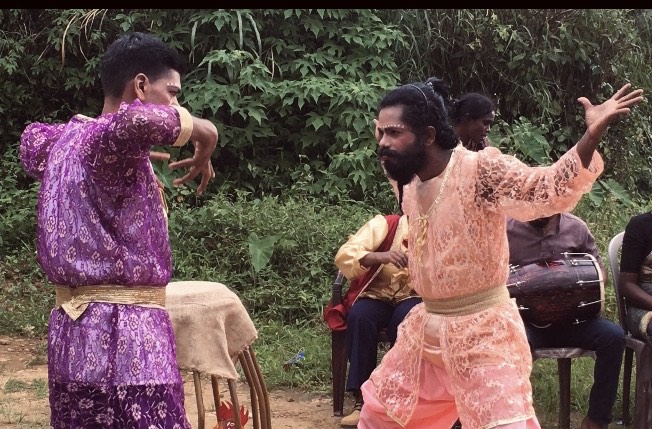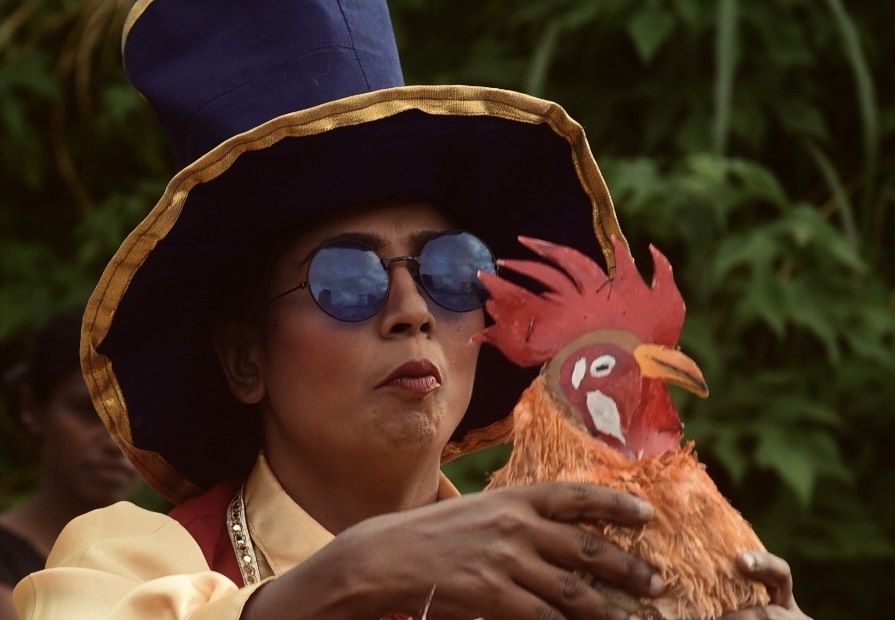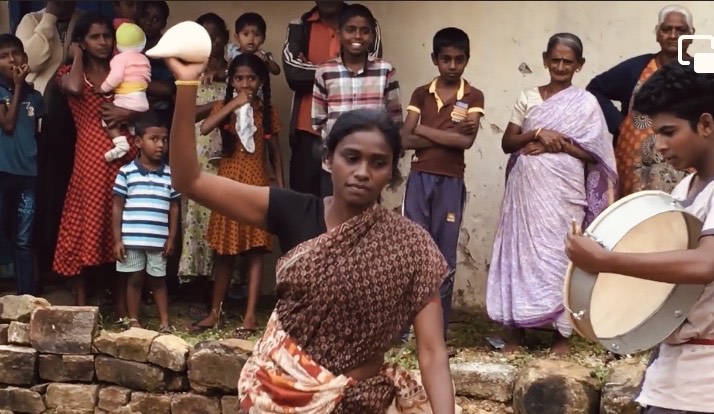By Nandana Nanneththi
Script, Direction and Music by: R Loganandan
KCostumes and Makeup: Selvaraj Lilavati
Drama Material: M. Navaneethan
Production: Theater Mates Culture Association, Kotiyagala

“Layattu Koligal” is a drama embodying the lives and struggle of estate workers, and is meant to be played either on the street or on the stage. Despite threats from the army, police, estate management and union leaders, it premiered on July 9 at Kotiyagala estate, Bogawantalawa. Later it was staged on July 16 and 18 at Kernerswold Middle Section and Champion Upper Section Estates subsequently, and will be staged in various parts of the island in the coming days.
The troupe faced a number of obstacles. An officer from the military unit in charge of the area, having been informed by his intelligence unit of the plan to stage the drama, contacted the director over the phone and warned him not to stage any event without first informing the military unit. Then, a union leader threatened that he cannot allow staging the drama, as it may create troubles for him.
Drama director Loganandan, explaining the difficult situation he faced, writes in a facebook post titled, “My life made sense on July 9”, as follows:
“On this day, I staged a drama in my own estate where I was born and brought up. The upper Section of Kotiyagala is my estate. Bogawantalawa is our nearest town. Theatre is my life. The roots that directed me in this direction was my Kotiyagala estate
“Our drama, started in a very simple way, eventually gained popularity with a social upheaval amid huge controversies. “Layattu Koligal” has become a historical event.
“This note… is regarding the courage of our people. That miracle happened when the commitment and hopes of our drama team were shattered. My dear brother Danas was able to handle the very people who harshly threatened us not to stage the drama, in a very simple manner. It is remarkable that he is the son of the former protester, uncle Mariasusei in our estate. I was touched by the self-respect displayed by the efforts of my dear brothers Prakash and Vimalkanth who stood shoulder to shoulder with me on this occasion. Their actions should be an example to many. My phone still assures me that Adambankodi (a strong twined vine used by workers for tying firewood together and for similar purposes) is waving from now on. There are signs of an intellectual change in the future. I am inspired by being able to stage the drama disregarding those who said that it would not be allowed to be played.
“How many people have hugged and embraced me after the play? Their eyes were overflowing with happiness. The joy that was shining on the faces of the children! It is indescribable. We have to do drama for them. Our journey will continue. We will roar as a great multitude.”

Even if we consider only the ambience that was described above, Layattu Koligal is a symbol of a struggle that inevitably demands for a historical change. The extraordinary form of the drama also arises from such a social requirement.
It is a story about a chicken theft. Murugan Andy (M. Ajanthan) and Andy Murugan (A. Navaneethan) are two chicken thieves. They both are competing with each other in stealing. Fowls are being stolen all over the area and people are fighting to protect their chicken from thieves. This fight is portrayed by the trio of a poor woman (S. Seedevi), her young son (S. Vasikaran) and another woman (Kalai Durasi) assisting them. Escalating the conflict between the thieves and the woman in the play, the poor woman entrusts the care of her fowl to her teenage son. The thieves try to trick him and steal the bird by giving him toys, and when they fail in this attempt, they finally threaten him with a firearm and forcibly take the chicken. A magician (S. Leelawathi), dressed in a garb that brings to mind Yankee imperialism, becomes the arbiter of the thieves’ struggle for the possession of the chicken, pulls currency notes from the chicken’s belly and pockets the notes herself. A few coins are thrown on the ground for thieves to pick up. The thieves get greedy and the magician hands them two torches and takes the chicken away.

Then the poor woman declares, with a heavy heart, “we are looking for a chicken throughout our entire lives. But what have we really lost? What we really lost is our own lives,”. It appears that the working class, including herself, who have nothing to lose but their own lives, have no choice but to fight. “We have lost our lives,” a worker on the Kerkerswald estate repeated before us, after watching the play. These very words will echo among plantation workers.

Drama Director Logananthan has identified the dramatic moments of his play, such as the attempt of the two thieves to steal the same chicken, trying to deceive each other in the act, the way the woman intervenes each time to disrupt their attempt, repetition of this sequence, the competition between the thieves after the woman entrusts the protection of the chicken to her teenage son, and the manifestation of the magician and her investigation of the thieves’ complaint on the ownership of the chicken. This proves his creativity, and he has also managed to keep the audience engaged with the play from the beginning to the conclusion of it.
The theatre style of the two main actors portraying the roles of the two thieves generates humor and opposition in the audience towards those characters. For them, it recreates the vile ruling class tendencies they confront in their day-to-day lives, nurturing from their flesh, blood and sweat, which includes the trade unions. Adopting Tamil Kuththu drama tradition for the costumes, make-up, gait, etc., the director, Loganandan makes the worker-audience see the characters away from their own lives as distant spectators. Also, it is notable that the costumes and performance of the magician, who takes possession of the property taken from the workers and gives a pittance to the thieves, is created to remind one of Western imperialism. Workers’ characters are created in a form somewhat closer to the realistic tradition, but somewhere in between the realistic and stylistic theatre styles, thereby giving the audience an opportunity to see themselves.

One feels that, apart from providing energy and rhythm to the act, the spectator also is directed towards the relationships repeatedly reflecting the estate workers’ surroundings and their lives, by creatively using the rhythms from membranophones familiar in the estate life, such as Thappu (Parai – a frame drum popular in estate workers) music used in Kuththu dramas. Thappu was used two hundred years ago, during the difficult journey of South Indian workers over the sea and then to the central mountains through forests, to ward off dangerous animals and for protection from them.
The thieves represent the trade unions and various right-wing, pseudo-left fronts, covering up the role of capitalist social order, and in revealing this relationship, the drama challenges this social order. As the lives deprived to the estate workers by this social order cannot be reclaimed under capitalism, it highlights the urgent need of the working class to take matters into their own hands in determining their own destiny. For this reason, Layattu Koligal can be regarded as a realistic work of art, which ignites the life aspirations of oppressed people.
Since the emotions conveyed by the play from the beginning to the end are of a class nature, and it evokes the moods of the working class, it is a creation that represents the historical need of the current stage of social development, and it is worth considering what social conditions awakened the composer for his creation.
The artist’s statement that we have already quoted will surely provide a sufficient answer. Commemorative notes are being written on the two hundred years of plantation workers’ lives in Sri Lanka. The anniversaries make the workers re-think about themselves. During the period of nearly four years that have passed since the COVID pandemic, the crisis of the class society is getting protracted and coming to the fore in a way that cannot be suppressed. Parallel to the anniversary, this crisis provokes sentiments among the estate workers.
A school-aged plantation girl named Ishalini of Diagama, Hatton, who had been employed as a domestic worker, committed suicide by setting fire to herself in July 2021. During our discussions with the estate workers, it was clear to us that the very flames that took Ishalini’s life are still burning within the hearts of workers. Ishalini is a symbol of fate in plantation lives. The Tamil people in the plantations, who are barely getting the basic needs like education, jobs and housing fulfilled, now have to face the problems of protecting their children from all evils including drugs. The divisions created by trade unions and capitalist politics and the suppression of the struggles of the working people by these movements are being questioned. Meanwhile, the unstable capitalist governments are determined to unleash the offencive, without allowing them any democratic rights. When the brutal collapse of living conditions could not be tolerated any more, the estate youth came forward for the first time, in a campaign that their parents should receive a salary of at least one thousand rupees per day. The trade unions betrayed that struggle. The genuine artist born in the plantation and brought up in the plantation environment cannot ignore these.

Veteran actress S. Leelawathie, who is a member of a family of plantation workers, in successfully recreating this bitter truth, colors the climax of the play by her short, but brilliant performance in playing the role of the magician, who represents the evil and tyrannical ruling class. In particular, she not only proved that she is an actress who has mastered the art of acting, but also that she understood and conceptually recreated the social need expressed in the play. Therefore, her performance stands out. There is no doubt that S. Siddevi’s acting skills will remain in the memory of the audience. M. Ajanthan and M. Navaneedan who acted as thieves are showing clearly that they have the potential to achieve the skills of Leelawathie, and by mastering the craft and understanding of the social situations of the characters, they will be able to illuminate the drama even more than it presently does. We can expect that the apprentice teenager S. Vaseekaran will extend the skills he has shown in delivering the dialogues, to the other areas of play acting as well.
Navaneedan’s set design is excellent. By creating the chicken, the chicken coop and toys, especially the firearm, in a way that is clearly seen as a toy, he contributes to a powerful emphasis on the theme of the play.
A recent step taken by the ruling class to curb such creations is the arrest of stand-up comedian Nathasha Edrisooriya for an art creation. Sirima Bandaranaike’s coalition government that came to power in 1970 launched a strong attack on arts. There are many artists who have been persecuted since then. Several years ago, the education authorities have acted to prevent students from creating plays that discuss social issues by banning the play “Velicham Veliye Illai” produced by the students and teachers of St Mary’s College, Bogawantalawa even after it was selected to the final round in the National School Drama Competition. Accordingly, only the old traditional art work and their new interpretations are permitted for students, and they also restrict that the traditional written language should be used in their artistic work. Now, according to the instructions given to the judges of drama competitions, the subject range of artistic creations has been subjected to various restrictions such as ‘no politics’, ‘no insults to religion’, etc.
Similarly, governments around the world do not tolerate freedom of art and expression. Only the artist who understands that art must be freed from capitalism for the sake of the freedom of art, can enter the struggle to protect the freedom of art and expression. An ‘art’ out of touch with social reality does not in any way serve the advancement of an advanced culture. So, the only force that is capable of taking the initiative in defending the real art, which recognises the utility of social progress, is the working class which defeated the movement against Layattu Koligal. Accordingly, being organised in Rank-and-File Workers’ action committees and building a people’s revolutionary movement, extending the hand of camaraderie across all divisions and boundaries are the foremost social responsibilities of today’s artist. As Loganandan notes, “We roar in great multitudes!”
[This article was originally published in Sinhalese here on July 20, 2023]










